Los Caracoles, the restaurant
The outdoor dining culture of Barcelona is vibrant and not easily outdone. The competition between food outlets is fierce and the variety of food offered in this city is staggering. People are spoiled for choice when it comes to eating out, and it would take more than a lifetimes’s living here to fully discover all interesting restaurants, tapas bars and cafés.
One interesting restaurant sits on Carrer Dels Escudellers, just off Barcelona’s most famous boulevard – La Rambla – in the Barri Gothic quarters of the city. Founded in the early 19th century by the Bofarull family, this interesting restaurant is serving authentic Catalonian cuisine.
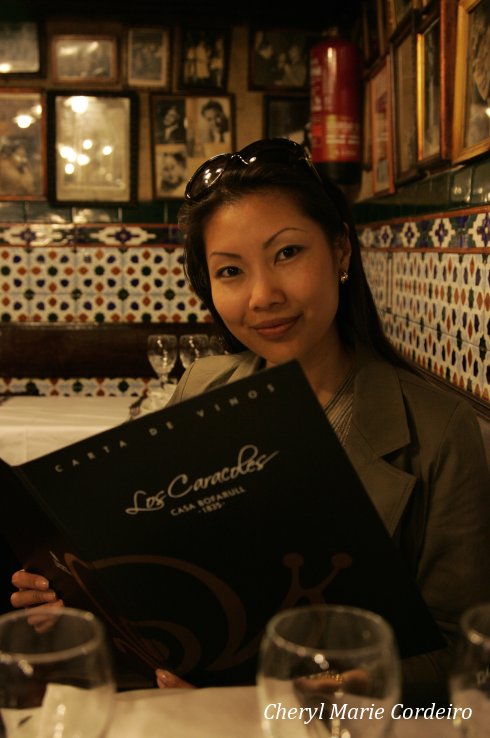
At Table 2, Los Caracoles. The restaurant has split level floors for seating for more than a hundred persons, discovered only after you walk past the short and narrow bar at the front of the restaurant. The walls of the restaurant are lined with photographs of previous patrons of fame.
Photo: JE Nilsson and C M Cordeiro-Nilsson © 2011
There were many curiosities about this restaurant that caught our attention on our visit. Their signature dish of Snails, prepared quite differently from the French escargot, got the restaurant so locally renowned in the early 1900s that the owners threw out their own last names in favour of the name of the dish calling the restaurant eventually, Los Caracoles or “The Snails”.
Many regular patrons will also tell of how you can’t possibly mistake finding the place because they fry their chickens rotisserie style outdoors on the actual road crossing. The combined visual effect of dancing vermilion flames on the street corner licking at chicken that is gradually turning golden brown, and the enticing aroma of the gently spiced meat that greet you along this narrow street is in itself an overwhelming experience to those who pass by.
But the entire visit, from beginning to end made us raise our eyebrows, first in curiosity and then with awe, mounting up to an extraordinary dining experience!
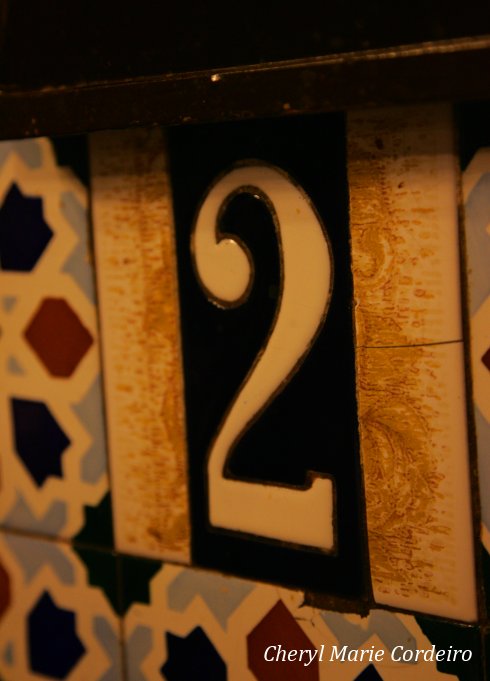
The restaurant is made up by an inumerable number of interconnected rooms. In the oldest sections tiled numbers on the walls help regular customers to have ‘their table’ for a lifetime.
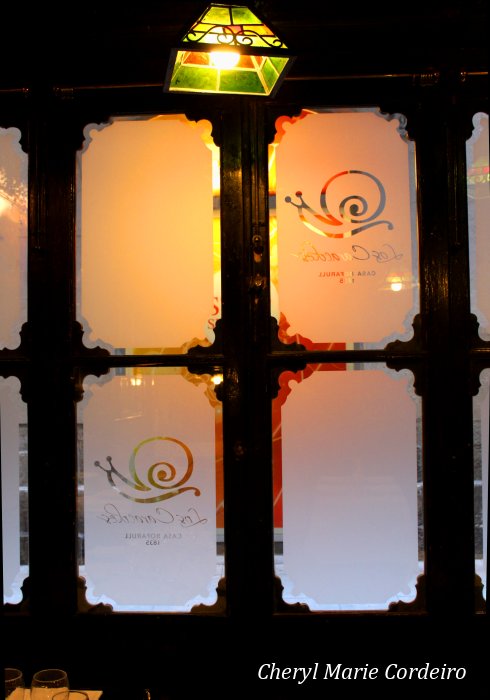
Window panes in the restaurant carrying the name of the restaurant.
We entered Los Caracoles at about 7:30 pm in the evening – early, by Catalonian standards for dinner of any sort and were greeted by an apparent lonesome bartender. The bar was empty of first guests for the evening, and we wondered if we were at the right place. We were just about to turn heel and head back for the main entrance turned exit when a friendly waiter approached and invited us in, “Dinner? You want the restaurant, no?” We nodded and in a blink, in usual Catalonian Mediterranean friendliness, we were grabbed by shoulder and elbows and decidedly invited into the restaurant section that to our surprise was accessed via the completely open kitchen that was dominated by a huge cast iron monstrosity of a stove, that was slowly being brought back to life for the evening by the chefs.
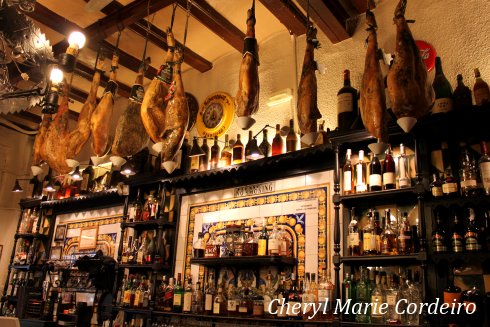
View of the bar, I.
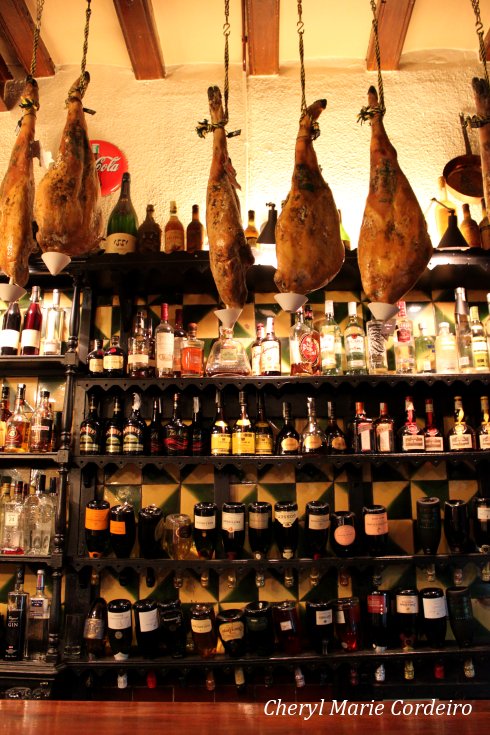
View of the bar, II.
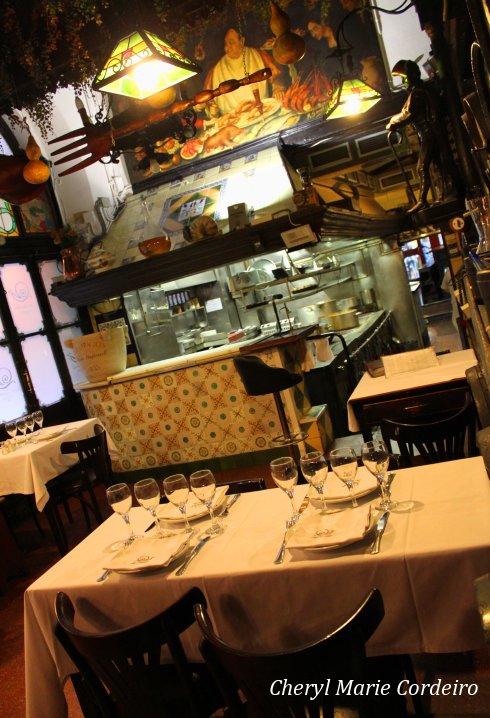
Seating that is literally at the heart of the restaurant, kitchen facing. There are many small dining halls in this restaurant, the best tables being the ones past the infernous kitchen, past the heart of the restaurant.
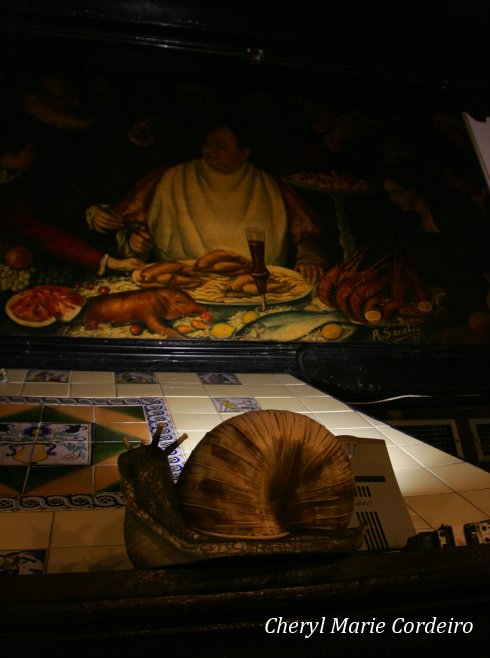
Snails… scattered in all forms of carving, prints and painting can be found through the restaurant…
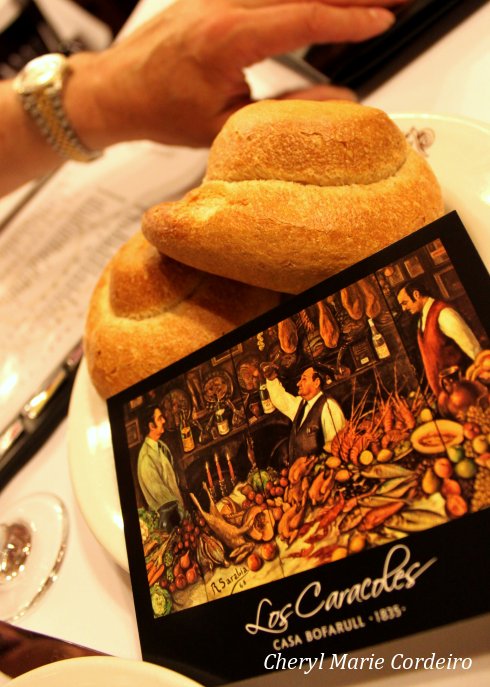
… even bread, baked in the shape of the shell of snails.
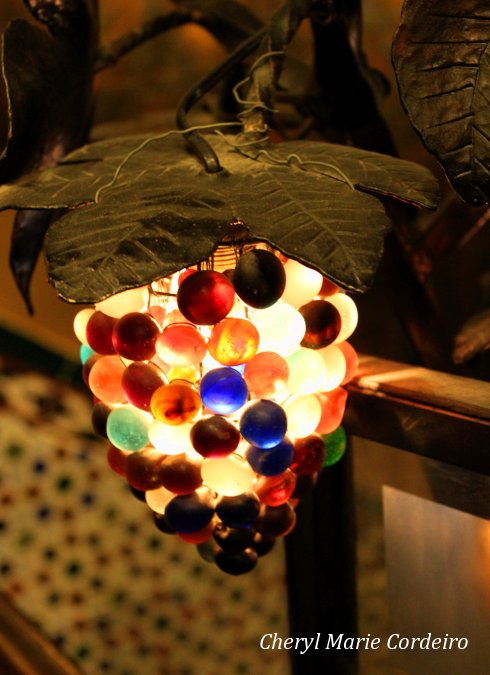
Stained glass lamps in the form of grapes and grape vines.
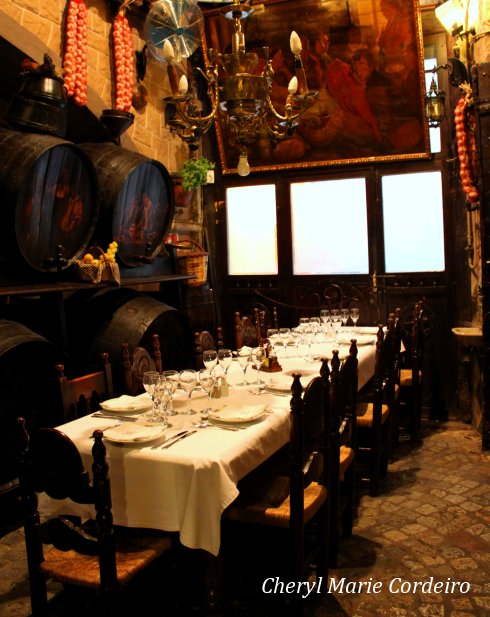
This private dining room in what I thought was quite Medieval in theme, from the cast iron fireplace to the well located to one corner of the room, seats about 10 to 14 guests comfortably. This room is semi-secluded, where seated here, you’ll get an impression of the night’s busy action anyway by the numerous guests streaming past from the first to the second floor.
The Open Inferno of a Kitchen!
Forget the snails and the grilled chicken. It was the blasting heat and activities of the kitchen that raged with all of Dante’s inferno that most guests have to navigate past to get to their tables that is the heart and soul of this restaurant. I believe it was only due to that the people who worked in that restaurant, who knew the dimensions of the kitchen so well that we managed to safely navigate ourselves through the bar, past the kitchen to our table and seats.
Past the kitchen, a rustic restaurant opens up in front of you, full of secret dining places and rooms on various floors. We grappled to put words to our feelings, our first impressions and observations of the fantastic stove we past, the floral tiles and wooden carved snails that dotted through the restaurant. The walls are plastered with photos of former patrons, of which you feel you are honored to be one. The waiter set us on a table that had a number in the wall – number 2 – a tiled number that has possibly been there since 1834 and seated, God knows whom. And to accompany our menu browsing were two pieces of bread, shaped like the shell of snails!
We couldn’t feel more at home than at Los Caracoles that evening….the service impeccably genuine, warm and efficient. The food, simply delicious! The atmosphere at the restaurant was so friendly that guests from the other tables started conversing with us, sharing with us their impressions of the place and what they ordered for dinner.
Food and Chefs
The sequence of pictures below show the firing up of the huge cast iron stove until it was in full swing, with the stove glowingly hot!
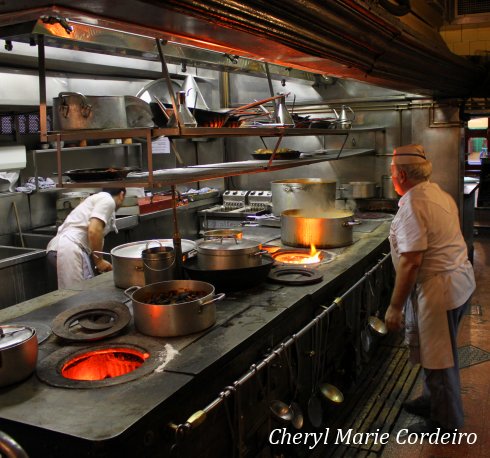
Early in the evening, the huge cast iron stove is being heated up.
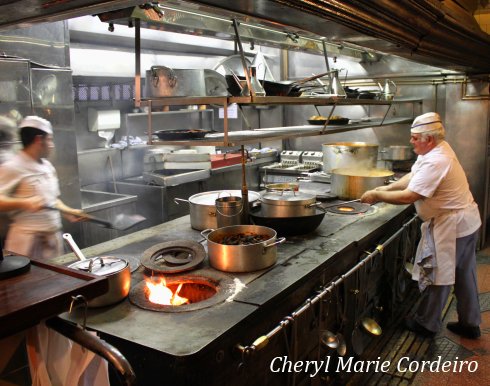
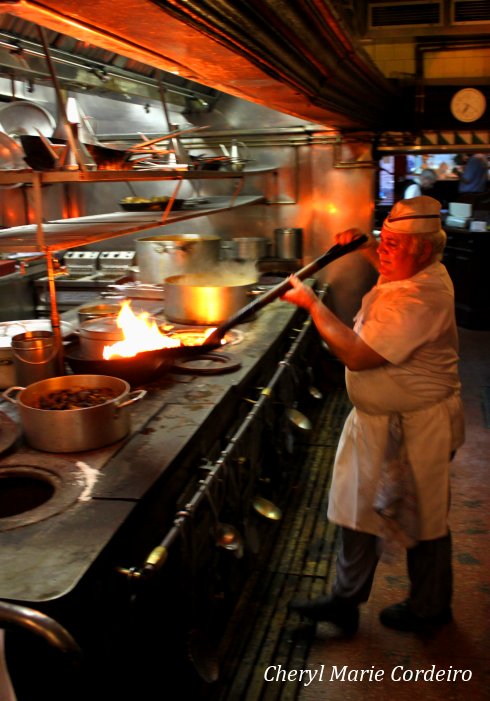
The intense heat makes it impossible to even stand near the stove for more than a few minutes. One would think that the high temperature by itself would make cooking impossible however we felt the range of dishes and the methods to cook them was tuned to the stove.
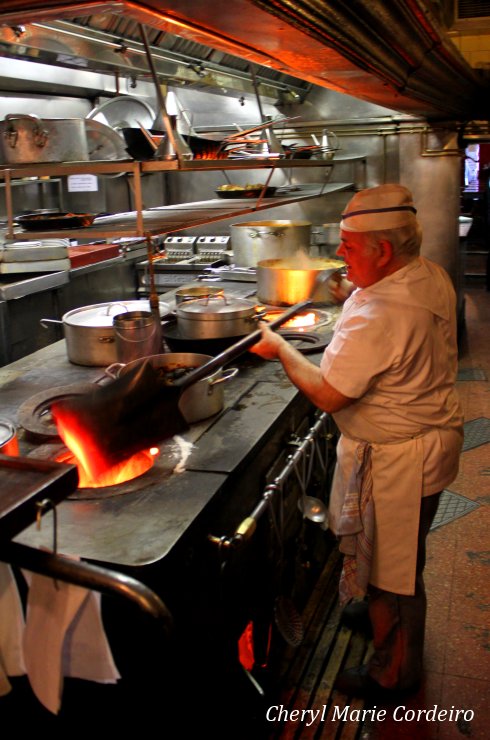
The fire in the stove is fed with more coal to get the real heat going for the expected crowd to arrive at the restaurant.
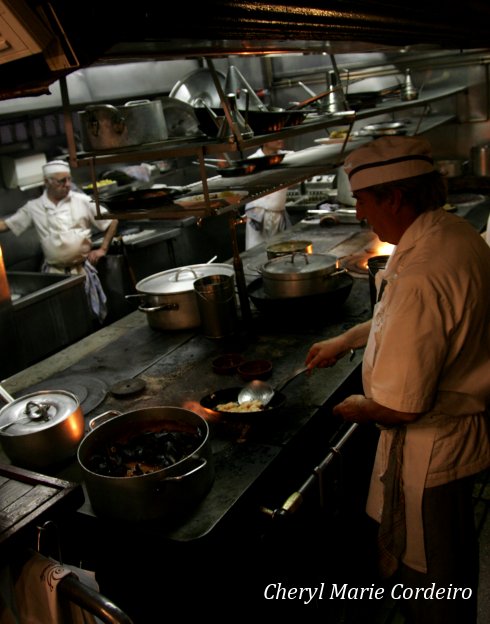
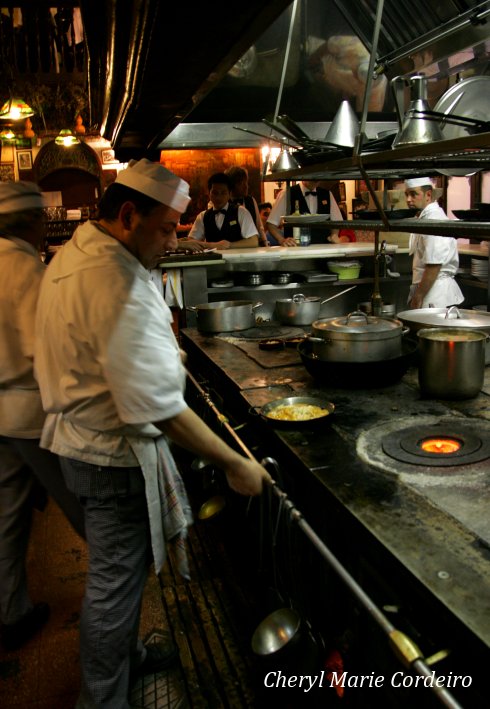
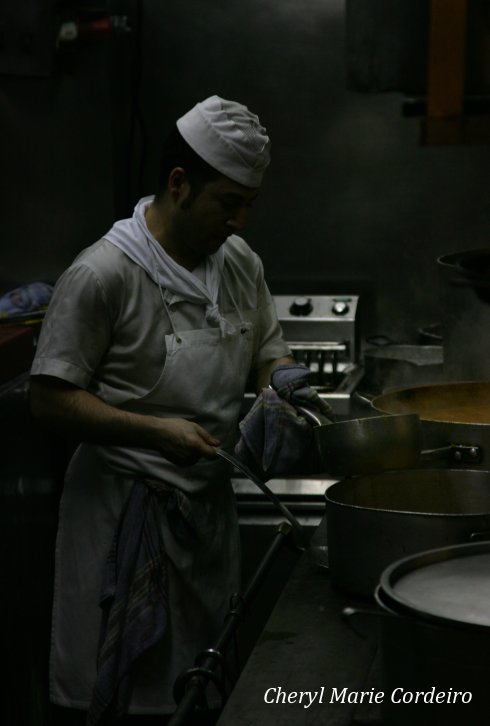
Mid-evening shots in the kitchen.
The Heart of the Matter
As the evening wore on, we noted that the kitchen did not just get warm, but the cast iron equipment got glowingly hot so that towards the end of the evening, all doors and windows on the ground floor were thrown open in order to cool down the place as quickly as possible. An early closing of the night for dinner by Catalonian standards goes way past midnight, into the small hours of the morning.
By the end of dinner, we still couldn’t mentally get around the more than century old concept of the heavy and solidly constructed cast iron stove that runs on black coal as the key element firing up the heart of the restaurant, giving life to the place itself.
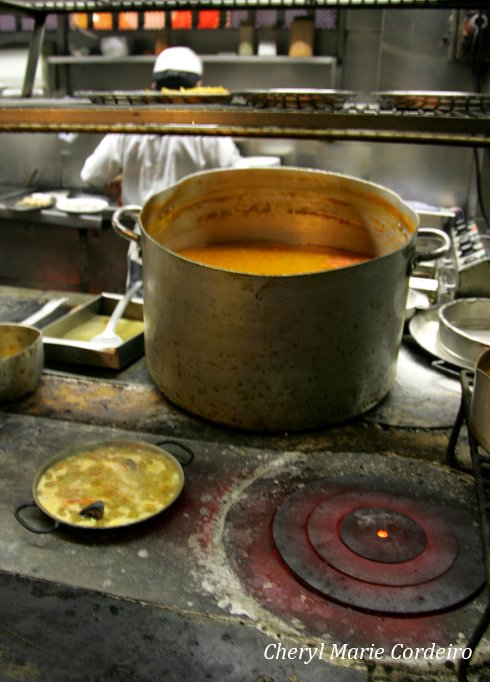
Late in the evening, after the last order has gone out, the stove is still visibly red and orange from heat! It’ll take an hour or so before the kitchen comes down to a comfortable temperature again.
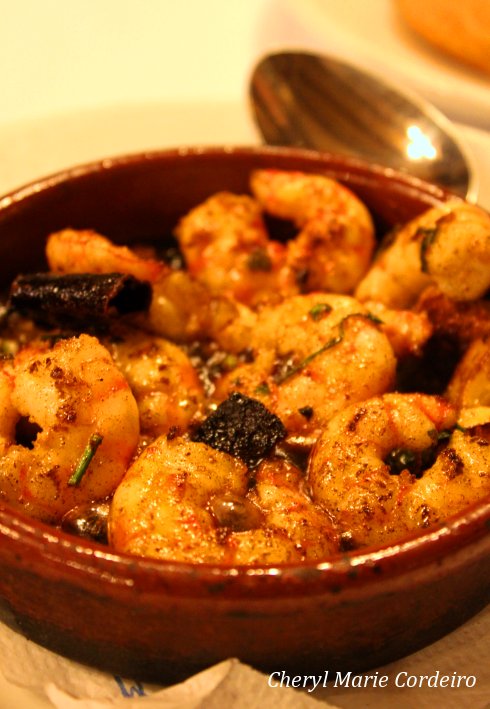
Garlic fried prawns served on a hot plate.
But even as the kitchen burned like Dante’s Inferno, the restaurant, its team of people and the food it produces, was a place far from Dante’s words of ‘l sol tace (where the sun is silent). The open kitchen, the very passion and temperament of the restaurant is complemented by the people who run the show in the restaurant who are passionate about their work. Through the night, they fill the place with numerous exemplars of love of their craft. This dynamic combination of factors, is what when shared with visitors and regulars alike, continues to keep alive a piece of Catalonian culinary history that is appreciated.
In my brief stay here at Barcelona, I’ve been back several times for dinner, enjoying every single visit to the place. And I couldn’t thank the Los Caracoles team enough for their generous show of heart and warmth in every single visit of mine! Thank You!
One thought on “Culinary Paradiso at Los Caracoles, Barcelona”